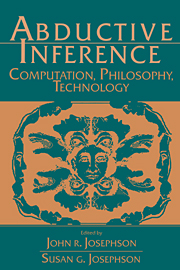Book contents
- Frontmatter
- Contents
- Contributors
- Introduction
- 1 Conceptual analysis of abduction
- 2 Knowledge-based systems and the science of AI
- 3 Two RED systems – abduction machines 1 and 2
- 4 Generalizing the control strategy – machine 3
- 5 More kinds of knowledge: Two diagnostic systems
- 6 Better task analysis, better strategy – machine 4
- 7 The computational complexity of abduction
- 8 Two more diagnostic systems
- 9 Better task definition, better strategy – machine 5
- 10 Perception and language understanding
- Appendix A Truth seekers
- Appendix B Plausibility
- Extended Bibliography
- Acknowledgments
- Index
4 - Generalizing the control strategy – machine 3
Published online by Cambridge University Press: 08 October 2009
- Frontmatter
- Contents
- Contributors
- Introduction
- 1 Conceptual analysis of abduction
- 2 Knowledge-based systems and the science of AI
- 3 Two RED systems – abduction machines 1 and 2
- 4 Generalizing the control strategy – machine 3
- 5 More kinds of knowledge: Two diagnostic systems
- 6 Better task analysis, better strategy – machine 4
- 7 The computational complexity of abduction
- 8 Two more diagnostic systems
- 9 Better task definition, better strategy – machine 5
- 10 Perception and language understanding
- Appendix A Truth seekers
- Appendix B Plausibility
- Extended Bibliography
- Acknowledgments
- Index
Summary
The PEIRCE tool
In the first generation of work on generic tasks the invocation of a generictask problem solver was pre-programmed, hard-wired during system programming. In RED-2 we wanted to test many variations of the algorithm empirically, but a significant amount of work was required to reprogram the system each time a change was desired. Also, the RED-2 hypothesis-assembly module seemed too “algorithmic,” too much like a rule follower and not enough like “fluid intelligence.” So we decided to analyze the system in terms of the goals and subgoals of abductive problem solving and to identify the different methods that were used to achieve the various goals. This analysis allowed us to reorganize the program in a way that made adding new methods and modifying the goal structure easy, so that we could better experiment with new strategies for abduction. For multiple methods to be available to achieve problem-solving goals, method selection would occur at run time based on the state of the problem and the availability of needed forms of knowledge. These efforts resulted in a programming tool called “PEIRCE” for building systems that perform abductive assembly and criticism in this more flexible manner.
Systems built with PEIRCE are examples of third generation abduction machines (where RED-1 is taken as the first generation and RED-2 as the second). PEIRCE allows for specifying strategies for dynamically integrating various hypothesis-improvement tactics, or operators, during the course of problem solving. The idea was to capture domain-independent aspects of abductive assembly and criticism and embed them in the tool, leaving domain-specific aspects to be programmed when building particular knowledge-based systems.
- Type
- Chapter
- Information
- Abductive InferenceComputation, Philosophy, Technology, pp. 94 - 116Publisher: Cambridge University PressPrint publication year: 1994

